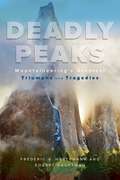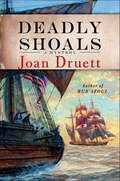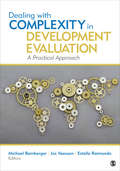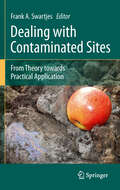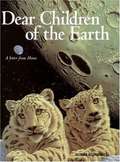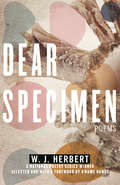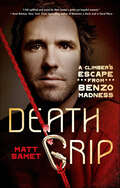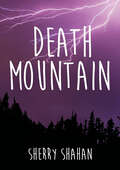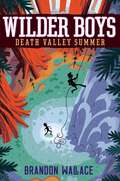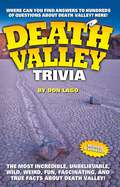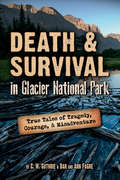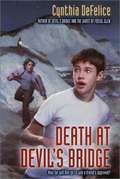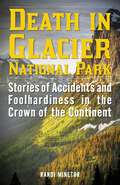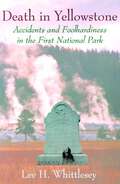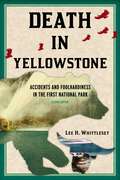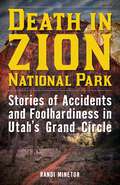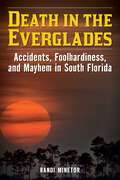- Table View
- List View
Dead Tree Media: Manufacturing the Newspaper in Twentieth-Century North America (Hagley Library Studies in Business, Technology, and Politics)
by Michael StammA deep and timely account of how American newspapers were produced and distributed on paper.Winner of the Best Book in Canadian Business History by the Canadian Business History AssociationPopular assessments of printed newspapers have become so grim that some have taken to calling them "dead tree media" as a way of invoking the medium’s imminent demise. There is a literal truth hidden in this dismissive expression: printed newspapers really are material goods made from trees. And, throughout the twentieth century, the overwhelming majority of trees cut down in the service of printing newspapers in the United States came from Canada. In Dead Tree Media, Michael Stamm reveals the international history of the commodity chains connecting Canadian trees and US readers. Drawing on newly available corporate documents and research in archives across North America, Stamm offers a sophisticated rethinking of the material history of the printed newspaper. Tracing its industrial production from the forest to the newsstand, he provides an account of the obscure and often hidden labor involved in this manufacturing process by showing how it was driven by not only publishers and journalists but also lumberjacks, paper mill workers, policymakers, chemists, and urban and regional planners. Stamm describes the 1911 shift in tariff policy that gave US publishers duty-free access to Canadian newsprint, providing a tremendous boost to Canadian paper manufacturers and a significant subsidy to American newspaper publishers. He also explains how Canada attracted massive American foreign investment in paper mills around the same time that US publishers were able to gain greater access to Canada’s vast spruce forests. Focusing particularly on the Chicago Tribune, Stamm provides a new history of the rise and fall of both the mass circulation printed newspaper and the particular kind of corporation in the newspaper business that had shaped many aspects of the cultural, political, and even physical landscape of North America. For those seeking to understand the travails of the contemporary newspaper business, Dead Tree Media is essential reading.
Deadly Peaks: Mountaineering's Greatest Triumphs and Tragedies
by Robert Hauptman Frederic V. HartemannDeadly Peaks is a collection of the most notable mountaineering disasters and near-disasters in history. Exhaustively researched by two of the most respected authorities on mountaineering history, the book is structured in a unique way: Longer recitations in chronological order followed by a group of briefer narratives, which all offer an intimate glimpse into the worst case-scenarios high altitude adventure can offer.
Deadly Shoals: A Mystery (Wiki Coffin Mysteries)
by Joan DruettWiki Coffin plays many parts on the U.S. Exploring Expedition---sailor, linguist, navigator, and, as half-Maori, cultural go-between. But then the brig Swallow reaches the coast of Patagonia, an area infamous for its rough gauchos and revolutionary spirit, and he must take on his other role, that of agent of U.S. law and order. A New England whaler shows up, desperate to find the devious trader who has cheated him of a thousand dollars and a schooner. Wiki is assigned to find the missing ship, only to follow a trail of clues to a dead body, half-buried in a hill of salt, its skull picked clean by vultures. The adventure unravels in the impoverished village of El Carmen de Patagones, where the threat of French invasion is imminent, and business is at a standstill under the orders of General de Rosas, the tyrant of Buenos Aires. Wiki must risk both life and reputation in pursuit of a vicious and determined killer who has set his sights on another target: the U.S. Exploring Expedition itself.
Dealing With Complexity in Development Evaluation: A Practical Approach
by Michael Bamberger Jos Vaessen Estelle RaimondoRecognizing that complexity calls for innovative, conceptual, and methodological solutions, this unique book offers practical guidance to policymakers, managers, and evaluation practitioners on how to design and implement complexity-responsive evaluations that can be undertaken in the real world of time, budget, data, and political constraints. Introductory chapters present comprehensive, non-technical overviews of the most common evaluation tools and methodologies, and additional content addresses more cutting-edge material. The book also includes six case study chapters to illustrate examples of various evaluation contexts from around the world.
Dealing With Complexity in Development Evaluation: A Practical Approach
by Michael Bamberger Jos Vaessen Estelle RaimondoRecognizing that complexity calls for innovative, conceptual, and methodological solutions, this unique book offers practical guidance to policymakers, managers, and evaluation practitioners on how to design and implement complexity-responsive evaluations that can be undertaken in the real world of time, budget, data, and political constraints. Introductory chapters present comprehensive, non-technical overviews of the most common evaluation tools and methodologies, and additional content addresses more cutting-edge material. The book also includes six case study chapters to illustrate examples of various evaluation contexts from around the world.
Dealing with Contaminated Sites
by Frank A. SwartjesThis standard work on contaminated site management covers the whole chain of steps involved in dealing with contaminated sites, from site investigation to remediation. An important focus throughout the book is on Risk Assessment. In addition, the book includes chapters on characterisation of natural and urban soils, bioavailability, natural attenuation, policy and stakeholder viewpoints and Brownfields. Typically, the book includes in-depth theories on soil contamination, along with offering possibilities for practical applications. More than sixty of the world's top experts from Europe, the USA, Australia and Canada have contributed to this book. The twenty-five chapters in this book offer relevant information for experienced scientists, students, consultants and regulators, as well as for 'new players' in contaminated site management
Dealing with Disasters: Perspectives from Eco-Cosmologies (Palgrave Studies in Disaster Anthropology)
by Pamela J. Stewart Andrew J. Strathern Davide Torri Diana RiboliProviding a fresh look at some of the pressing issues of our world today, this collection focuses on experiential and ritualized coping practices in response to a multitude of environmental challenges—cyclones, volcanic eruptions, tsunamis, earthquakes, warfare and displacements of peoples and environmental resource exploitation. Eco-cosmological practices conducted by skilled healing practitioners utilize knowledge embedded in the cosmological grounding of place and experiences of place and the landscapes in which such experience is encapsulated. A range of geographic case studies are presented in this volume, exploring Asia, Europe, the Pacific, and South America. With special reference throughout to ritual as a mode of seeking the stabilization, renewal, and continuity of life processes, this volume will be of particular interest to readers working in shamanic and healing practices, environmental concerns surrounding sustainability and conservation, ethnomedical systems, and religious and ritual studies.
Dear Children of the Earth
by Schim SchimmelThis illustrated letter from Mother Earth is designed to remind children of all ages of the responsibility we all have to protect the world in which we live. It poses then answers to the question: what can we do to help save our home?
Dear Papa: Letters Between John Muir and His Daughter Wanda
by Jean Hanna Clark Shirley SargentLetters between the famous naturalist and his daughter.
Dear Specimen: Poems
by W.J. HerbertA National Poetry Series winner, selected and with a foreword by Kwame Dawes.A 5-part series of interwoven poems from a dying parent to her daughter, examining the human capacity for grief, culpability, and love, asking: do we as a species deserve to survive? Dear Specimen opens with both its speaker and her planet in peril. In &“Speak to Me,&” she puzzles over a millipede, as if the blue rune of its body could help her understand her impending death and the crisis her species has created. Throughout the collection, poems addressed to specimens echo the speaker&’s concern and amplify her wonderment. A catalog of our climate transgressions, Dear Specimen&’s final poem foretells a future in which climate refugees overrun one of our planet&’s last habitable places. The collection&’s lifeblood is a series of poems in which the speaker and her daughter express their concern for, and devotion to, one another. The daughter&’s questions mirror the ones her mother asks of specimens: what are we meant to do with so much hazard and wonder? When the speaker hints at the climate crisis in a bedtime story she tells her grandson, we, too, feel the peril he may face. Juxtaposing a profound sense of intimacy with the vastness of geological time, the collection offers a climate-conscious critique of the human species—our search for meaning and intimacy, our capacity for greed and destruction. Dear Specimen is an extended love letter and dire warning, not only to the daughter its speaker leaves behind but to all of us.
Dear Treefrog
by Joyce SidmanCapturing the joy of finding a kindred spirit, this stunning picture book by Newbery Honor–winning poet Joyce Sidman tells the story of a lonely girl moving into a new home and the little treefrog that helps her connect to the beautiful world around her. Perfect for fans of A Butterfly Is Patient and They Saw a Cat.I See You suddenly among the tangled green a tiny dollop of frog where before there was only leaf . . . Are you new here too? When a shy girl moves to a strange new home, she discovers a treefrog perched in a secret spot nearby and learns that sometimes, all it takes to connect with the people and the world around us is a little patience, a curious mind, and a willingness to see the world through a different perspective than your own. With beautiful gouache illustrations by Diana Sudyka and magical, perceptive poems from Newbery Honor–winning author Joyce Sidman, the lives of one tree frog and the girl who discovers it converge, bringing solace, courage, and joy in finding a kindred spirit.
Death Grip: A Climber's Escape from Benzo Madness
by Matt SametDeath Grip chronicles a top climber's near-fatal struggle with anxiety and depression, and his nightmarish journey through the dangerous world of prescription drugs. Matt Samet lived to climb, and craved the challenge, risk, and exhilaration of conquering sheer rock faces around the United States and internationally. But Samet's depression, compounded by the extreme diet and fitness practices of climbers, led him to seek professional help. He entered the murky, inescapable world of psychiatric medicine, where he developed a dangerous addiction to prescribed medications—primarily "benzos," or benzodiazepines—that landed him in institutions and nearly killed him.With dramatic storytelling, persuasive research data, and searing honesty, Matt Samet reveals the hidden epidemic of benzo addiction, which some have suggested can be harder to quit than heroin. Millions of adults and teenagers are prescribed these drugs, but few understand how addictive they are—and how dangerous long-term usage can be, even when prescribed by doctors.After a difficult struggle with addiction, Samet slowly makes his way to a life in recovery through perseverance and a deep love of rock climbing. Conveying both the exhilaration of climbing in the wilderness and the utter madness of addiction, Death Grip is a powerful and revelatory memoir.
Death Mountain
by Sherry ShahanAn afternoon hike in the Sierra Mountains turns into a struggle for survival when two teenage girls become hopelessly lost in an electrical storm and must rely on their own wits and strength to endure.Almost a year ago, Erin's mother Lannie suddenly left home without any explanation. Now Lannie wants to see her, but Erin feels miserable and unsure about seeing her mother again.After "losing" her bus ticket on the way to visit her mother, Erin hitches a ride with Mae and her older brother, Levi. Along the way, she joins the two siblings for a hike along the eastern slope of the Sierra Nevada Mountains. When a deadly storm suddenly descends upon the mountain and lightning strikes, everyone on the crowded trails scrambles for safety and Erin and Mae become separated from the others. As the days pass, the two stranded girls must rely on their own determination and skills, as well as each other, to survive.Author Sherry Shahan's dramatic story displays perceptive insights into the conflicted hearts and minds of teenagers, as well as a thorough understanding of the natural world and technical details of mountaineering. An afterword includes details of Shahan's own harrowing alpine adventure that inspired the novel.
Death Valley Summer (Wilder Boys)
by Brandon WallaceTwo brothers try to lead lost campers to safety in the fourth adventure of the Wilder Boys series.The boys help out at a wilderness camp near Sequoia National Park, a day&’s drive south of the Sierras. The camp&’s main draw is a multi-day trek traversing woodlands, mountains, and desert during a team-based orientation competition that will take them to the edge of Death Valley. When Jake and Taylor&’s team counselor is badly hurt in a flash flood, they must galvanize the lost campers to find shelter, aid the injured counselor, and supplement their low supplies with what can be found around them. At first, stumbling across a ghost town seems like a lucky break from the scorching heat of summer, but the town is already occupied by counterfeiters who are none too pleased about their operation being discovered. The boys must use all their resourcefulness and knowledge of the outdoors to protect their teammates from the criminals and the elements.
Death Valley Trivia
by Don LagoThe most incredible, unbelievable, wild, weird, fun, fascinating, and true facts about Death Valley National Park.Death Valley National Park is full of wonder - and so is this book. Here you will find the biggest and smallest, longest and shortest, first and last, weirdest and wildest, and the who, what, and where of Death Valley. From Telescope Peak to Badwater Basin and everything in between, Death Valley Trivia offers something fascinating, fun, and little known about the area's landscapes, geology, plants, wildlife, weather, explorers, prospectors, outlaws, celebrities - and more.Carry it on a hike, read it in your car, and take it home to enjoy again and again. Play a Death Valley trivia game with family and friends! These trivial trifles, treasures, and treats will keep you laughing, learning, and guessing. It's fun-tastic!
Death Valley in '49: An Autobiography of a Pioneer Who Survived the California Desert
by William ManlyA survivor’s true account of death, despair, and heroism in Death Valley in the heat of the California Gold Rush. At the height of the California gold rush in 1849, a wagon train of men, women, children, and their animals stumbled into a 130-mile-long valley in the Mojave Desert while they were looking for a shortcut to the California coast. What ensued was an ordeal that divided the camp into remnants and struck them with hunger, thirst, and a terrible sense of being lost beyond hope—until a twenty-nine-year-old hero volunteered to cross the desert to get help. This young hero, William Lewis Manly, was one of the survivors of the tragedy, and he lived to tell the tale forty-five years later in this gripping autobiography, first published in 1894. In a time of unmarked frontiers and wilderness, Manly lived the true life of a pioneer. After being hit by gold rush fever Manly joined the fateful wagon train that would get swallowed up by the barren, arid, hostile valley with its dry and waterless terrain, unearthly surface of white salts, and overwhelming heat. Assaulted and devastated by the elements, members of the camp killed their emaciated oxen for food, ran out of water, split up, and lost and buried their own kind who perished. When Manly’s remaining band of ten came across a rare water hole, he and a companion, John Rogers, left the rest by the water and crossed the treacherous Panamint Mountains and Mojave Desert by themselves in search for rescue. In a true act of heroism against all odds, the two finally returned twenty-five days later with help, rescuing their compatriots, including four children, even when it seemed all hope was lost. Told at the end of the nineteenth century, Manly’s compelling and stirring account brings alive to modern-day readers the unimaginable hardships of America’s brave pioneers, and a chapter in Californian history that should not be forgotten.
Death and Survival in Glacier National Park: True Tales of Tragedy, Courage, and Misadventure
by C. W. Guthrie Ann Fagre Dan Farge<p>Sheer cliffs, avalanches, turbulent rivers, cold lakes, severe weather, grizzly bears - these are just a few of the ways you can die while visiting Glacier National Park. <p>Since 1910 when the park was established, 296 people have perished within Glacier's boundaries, and many more somehow survived close calls with death. Death and Survival in Glacier National Park recounts their true tales, as well as stories of the brave and often heroic search-and-rescue professionals who put their lives on the line so that others might live. <p>Written by local Glacier National Park experts. Jam-packed with gripping stories of courage and survival against all odds. Featuring the most complete chronology of all 296 deaths in Glacier National Park, including names, ages, locations, and causes.</p>
Death at Devil's Bridge
by Cynthia DefeliceThirteen-year-old Ben Daggett is looking forward to his summer job as first mate on a charter fishing boat on Martha's Vineyard. Then, on his first day out, he spots a strange object in the water -- a red Porsche. The driver is missing. Donny, an older teenager, knows something, but he's not telling. Donny has his own car, and Ben would give anything to hang out with him. But Donny's involved in something shady, and Ben finds out that the price of friendship may be more than he can afford to pay.
Death in Glacier National Park: Stories of Accidents and Foolhardiness in the Crown of the Continent (Death in the National Parks)
by Randi MinetorAdventures in the wilderness can be dramatic and deadly. Glacier National Park&’s death records date back to January 1913, when a man froze to death while snowshoeing between Cut Bank and St. Mary. All told, 260 people have died or are presumed to have died in the park during the first hundred years of its existence. One man fell into a crevasse on East Gunsight Peak while skiing its steep north face, and another died while moonlight biking on the Sun Road. A man left his wife and five children at the Apgar picnic area and disappeared on Lake McDonald. His boat was found halfway up the west shore wedged between rocks with the propeller stuck in gravel. Collected here are some the most gripping accounts in park history of these unfortunate events caused by natural forces or human folly.
Death in Mount Rainier National Park: Stories of Accidents and Foolhardiness on the Northwest's Most Iconic Peak (Death in the National Parks)
by Tracy SalcedoEach year almost two million visitors come to Mount Rainier National Park. If they don&’t follow safety warnings, they may find themselves victims of a climbing accident, or face-to-face with a mountain lion, or stuck in the fog and snow on the Muir Snowfield, a place that is continually rated as one of America&’s most dangerous hikes. Death in Mount Rainier National Park gathers some of the most dramatic stories of the more than 400 deaths that have occurred in the park&’s history.
Death in Rocky Mountain National Park: Accidents and Foolhardiness on the Continental Divide (Death in the National Parks)
by Randi MinetorColorado&’s Rocky Mountain National Park welcomes more than 4 million visitors every year, but this jewel of America&’s parks has seen more than its fair share of deaths among its tourists. More than 70 people have perished attempting to climb Longs Peak, the park&’s tallest mountain—some of whom vanished into the wilderness, never to be found. Thousand-foot falls from high rock ledges, hypothermia, avalanches that bury climbers, lightning strikes, a historic flood, and even plane crashes are among the ways that park visitors have met a bad end. Author Randi Minetor also provides tips for staying alive and safe in the Rocky Mountains.
Death in Yellowstone: Accidents and Foolhardiness in the First National Park
by Lee H. WhittleseyIntriguing stories of how people have died in Yellowstone warn about the many dangers that exist there and in wild areas in general.
Death in Yellowstone: Accidents and Foolhardiness in the First National Park (Death in the National Parks)
by Lee H. WhittleseyThe chilling tome that launched an entire genre of books about the often gruesome but always tragic ways people have died in our national parks, this updated edition of the classic includes calamities in Yellowstone from the past sixteen years, including the infamous grizzly bear attacks in the summer of 2011 as well as a fatal hot springs accident in 2000. In these accounts, written with sensitivity as cautionary tales about what to do and what not to do in one of our wildest national parks, Whittlesey recounts deaths ranging from tragedy to folly—from being caught in a freak avalanche to the goring of a photographer who just got a little too close to a bison. Armchair travelers and park visitors alike will be fascinated by this important book detailing the dangers awaiting in our first national park.
Death in Zion National Park: Stories of Accidents and Foolhardiness in Utah's Grand Circle (Death in the National Parks)
by Randi MinetorMorbid, but strangely fascinating accountsIn 2015, a group of seven hikers were killed when a sudden flood struck Keyhole Canyon in Zion National Park. Prior to that, the steep, narrow route to Angels Landing led to at least five fatalities. Numerous people have found that high, exposed places in Zion—such as rim trails—are bad places to be in lightning storms. Death in Zion National Park collects some of the most gripping accounts in park history of the unfortunate events caused by natural forces or human folly.
Death in the Everglades: Accidents, Foolhardiness, and Mayhem in South Florida (Death in the National Parks)
by Randi MinetorHidden in the tall grasses and shallow waters of the Florida Everglades are true tales of mysterious deaths, clandestine crime, and disasters, both natural and manmade. Desperados fled here after escaping from prison, rum runners gunned down their enemies, and killers slipped their prey into canals as food for reptilian wildlife. Commercial airlines crashed and burned in the sawgrass, while smaller planes vanished from view. Hurricanes tore through the region, forcing Lake Okeechobee to overrun its banks and wipe out entire towns. And every once in a while, an alligator made someone its lunch. Collected here are some of the most gripping accounts in Everglades history, caused by natural forces, crime, operator error, or human folly.

